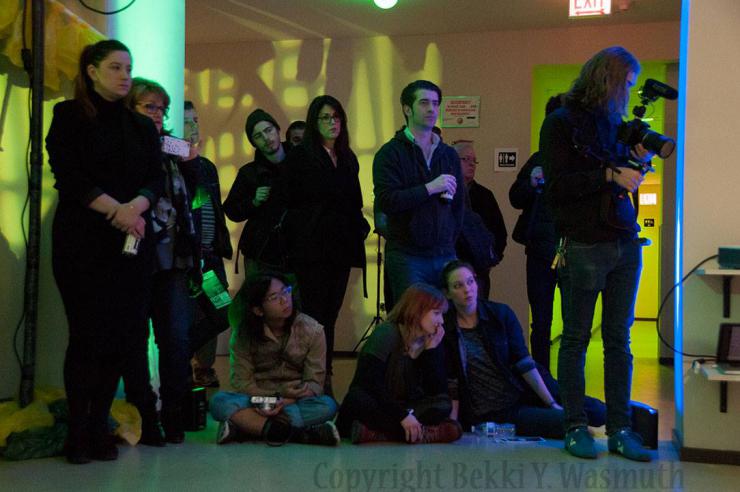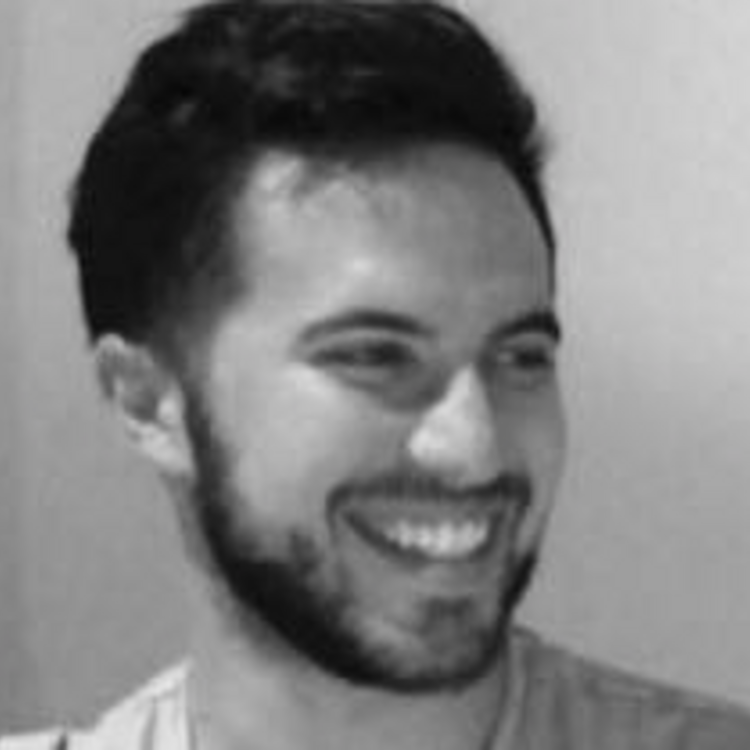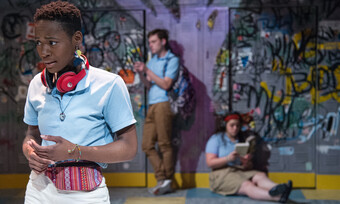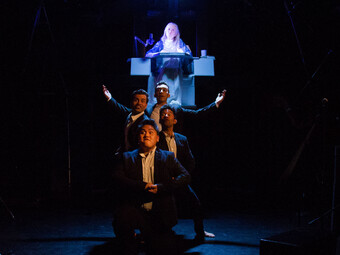Art Forms in Flux
Introduction
Art Forms in Flux (AFIF) documents a new creation and production process in Chicago’s contemporary theatre world, exploring a new model by Two Lights Theatre Company in which a diverse range of art forms will create work inspired by the text of a new play.
For the past eight years, Two Lights Theatre Company has been combining art forms side by side in their plays. We’ve held gallery shows in front lobbies, surrounded set designs with installations, and devised live bands for transitions. Somehow these efforts have not been enough. Our Chicago not-for-profit theatre was unsatisfied and sought a way to engage our community by making a near seamless integration of disciplines, almost subconscious in the audience experience and ingrained in our process.
Here we are now in 2016, having chosen our next play and with it, one giant experiment. We wonder if other theatre companies might be looking to think more imaginatively in their programming, and so we perform an honest assessment of how we might succeed...or not, a crucial step in understanding our hypothesis.
Let’s set the scene: Like we said, the crew has finally selected our next script. Everyone creatively involved with our small but mighty company is super relieved and ready to get started turning abstract ideas into tangible realities. All we need to do is “dive into the script,” and from there our concept will evolve. The concept will evolve, but how do we make it better than last time? How is it going to be genuinely ours—a bona fide Two Lights production? How do we make sure we’ve cultivated the most creativity possible? And from diverse outlets?
We look to our mission statement and recalibrate: “TLTC is a prism for theatrical ideas.” What starts out as an obscuring white light passes through the team, and comes out as clearly defined, diverse but cohesive intentions.

In the past, it’s been a challenging experience for a group like ours to feel the pressures of chugging out show after show. What’s worse was the push to raise thousands of dollars in a matter of months only to open and close; we ended up feeling like everything happened in the blink of an eye. This routine left us thinking, “Oh, damn. Wish we made time to try that,” or “Was that even our intention?”
During the early stages of production, we subject our “concept” to a rigorous experimentation. We throw out ideas, sometimes immediately shutting them down, but often running them through the metaphysical track again and again, like a crash test dummy. We are going to find a way to incorporate a fiberglass claw foot tub or a six-foot carp we hauled home from Goodman Theatre’s prop warehouse give-away. Let’s not forget the 15x30 feet of Astroturf we invested in for the last production.
Somehow, it doesn’t seem right to treat a story like this. We should be more careful with it, more gentle and encouraging. Set it on the windowsill in a plastic bag with a wet paper towel. Let it germinate in that adorable little greenhouse behind our beautiful Greystone and read to it daily.
We look to our mission statement and recalibrate: “TLTC is a prism for theatrical ideas.” What starts out as an obscuring white light passes through the team, and comes out as clearly defined, diverse but cohesive intentions. Prisms can come in the forms of different media, so what will best serve our process this time around? In a post-postmodern era, the creation of theatre through deconstruction is old news. We sought the new chapter: not an uncovering of the story’s pieces distributed beat by beat, but rather, a discovery by way of layering perspective and idea.
The word appeared to us in a designer’s biography for a performance art piece that utilized augmented reality: Fluxus. The word looked cool, so it got Googled. Art historian and scholar Lisa Wainwright loosely defines Fluxus (1960s-1970s) as “an international group of artists, poets, and musicians whose only shared impulse was to integrate life into art through the use of found events, sounds, and materials, thereby bringing about social and economic change in the world.” Using a sense of humor and indeterminacy, Fluxus was born in the form of festivals, mail art, and events that followed the 1950’s happenings of the post-Dada era. As one of the most under appreciated moments in art’s long documented history, Fluxus has permeated every crevice of the contemporary. It was a moment to break free by introducing an attitude of fluidity in response to the hard angles and both the literally and intellectually heavy work of the 1960s. This is not to say that Fluxus wasn’t highly conceptualized by its early founders George Maciunas and Dick Higgins, but its effects introduced and exploded art practices in a reverberation still felt today.

Eerie whispers of historical visionaries began to enter our company meetings. All it took was a chance encounter with The Hairpin Arts Center in Chicago’s Logan Square neighborhood and a generous collaborative grant awarded by The Chicago Community Trust, and we were on our way to planning a process unique to anything on the current market:
Art Forms in Flux. Two Lights Theatre Company has invited seventeen artists to be in residence and produce original work based on a new play entitled State Park by local playwright Aaron Weissman. Painters, sculptors, dancers, musicians, fashion designers, projection mappers, new media performers, installation artists, and more, will all work from one point of inspiration—the script. This will be our chosen vehicle for designing the experience of our story. Art Forms in Flux will harness the attitude of Fluxus in concert with theatre. Not only will it give our group the chance to radiate ideas from many perspectives, AFIF will synchronize an organic curiosity around the work through a lateral-community building process. The work created by our seventeen “Fluxists” will carry through into the full production of State Park next fall. In the form of exterior programming, the network and concepts developed in Flux will be given room to grow.
From a structural standpoint, Art Forms in Flux takes place prior to the play in the form of two stages. Artists will respond to the text not having experienced the play itself aside from hearing it read aloud once. The public is invited to attend, experience, and delight in the creations of the artists at two Public Openings. The exhibitions will conclude in a panel between the programming’s curator, the exhibited artists, and the play’s production team.
It is here, on the HowlRound platform, Two Lights documents our experiment’s findings during a season of multidisciplinary exhibitions and a full production. If you’re wondering how all this will unravel, so are we. A few more word clouds, a billion more brainstorm meetings, and the pastures of creativity will be fertile for a fruitful fall harvest.












Comments
The article is just the start of the conversation—we want to know what you think about this subject, too! HowlRound is a space for knowledge-sharing, and we welcome spirited, thoughtful, and on-topic dialogue. Find our full comments policy here